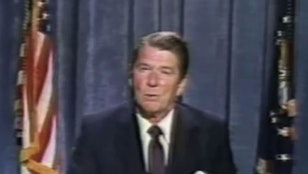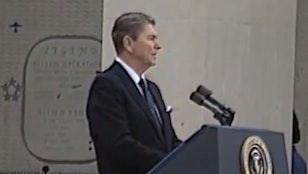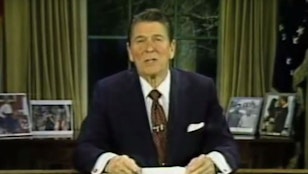
The Presidency
Foreign Policy
Making the World Over Again
The impact of the Reagan Presidency was undeniably positive. America’s foreign policy was clear and consistent. We stood by our allies and resisted adversaries spreading oppressive systems. Both friends and foes knew Reagan kept his word. America was once again the beacon of freedom worldwide.



Representing America Abroad
Truth to tell, President Reagan was not exactly a fan of traveling – especially if it meant to far away places without Nancy. Once when talking to an aide about some upcoming foreign travel and the number of flights required, the President said “the highest I want to go is on the saddle of a horse.” But he understood the importance of representing America abroad and of forming relationships with his counterparts. He climbed the steps of Air Force One many times over the eight years, visiting more than two dozen countries.
When he stood in a foreign capital and heard “The Star Spangled Banner” played by the host country’s band, President Reagan seemed to stand just a little taller and his chest swelled ever so slightly. You could almost feel his pride in representing the USA.



Making America a Force for Peace Around the Globe
Reagan believed fervently in the greatness and goodness of America, and knew that American strength was central to world peace. One of his first priorities as President was taking a demoralized and underfunded U.S. military and giving it the support and resources it needed to keep America safe and to be a force for peace around the globe.
Nothing made him prouder than to be Commander in Chief. You could see in his face how much it meant to receive – and return – a salute. He felt a special bond with the men and women in uniform, especially the young people from the small towns across America. That they were willing to risk their lives for their country never ceased to amaze and humble President Reagan. He took no responsibility more seriously than to keep them out of harm’s way. But he made a commitment to them that if it ever became necessary to send them into battle, he would make sure they had what they needed to get the job done.
By the time President Reagan left office, the U.S. military budget had increased 43% over the total expenditure during the height of the Vietnam War. Troop levels increased, there were significantly more weapons and equipment and the country’s intelligence program was vastly improved.



Reagan, Thatcher, and the Special Relationship between the U.S. and U.K.
Ronald Reagan strengthened the military because he was a realist. He understood the world, and had a clear sense of what America’s role should be – the champion of freedom for peoples everywhere.
Perhaps his most steadfast ally in that pursuit was British Prime Minister Margaret Thatcher. From the day they met, the two just “clicked.” They saw the world in similar ways, and found themselves in agreement on most global issues. The U.S. and British were said to have a “special relationship,” perhaps best evidenced by the fact that the Reagans’ first State Dinner in 1981 and last State Dinner in 1988 were both in honor of Mrs. Thatcher.
The special relationship between the U.S. and the U.K. was not limited to the Prime Minister. Indeed, the Reagans and the British Royal family came to like each other quite a bit, so much so that Queen Elizabeth II invited President Reagan to go horseback riding with her at Windsor Castle, and Mrs. Reagan was an honored guest at two Royal weddings.

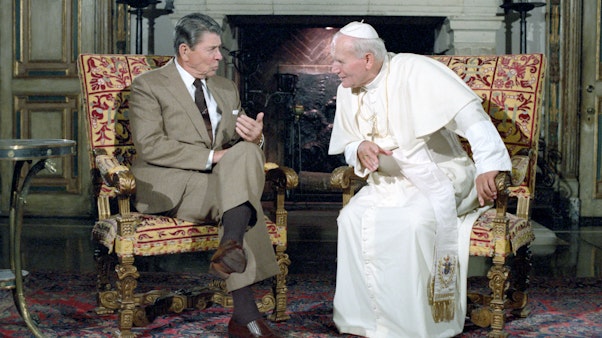
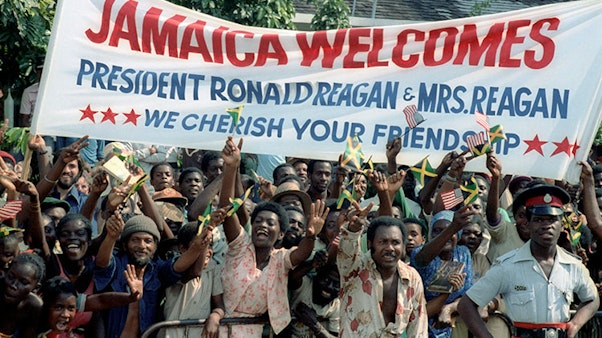
Global Advocacy for Democracy and Freedom in Foreign Nations
Poland Becomes a Free Nation
Pope John Paul II was another leader with whom President Reagan had a special rapport. As they came to know each other, they found they had similar views about Communist domination of Eastern Europe, and quietly worked together to support the Solidarity movement which eventually led to Poland becoming a free nation.
First Time Democratic Elections Around the World
While President Reagan was in the White House, free, democratic elections were held for the first time in many years in the Republic of Korea, Brazil, Argentina, Uruguay, Bolivia, Guatemala, El Salvador, Honduras and the Philippines. By the time President Reagan left office, the number of people in Latin America living under freely elected governments tripled from what it had been ten years earlier.
Liberating Grenada
In 1983, when President Reagan was asked by the Organization of Eastern Caribbean States, he sent U.S. troops to Grenada to lead a multi-national force in liberating that country from an oppressive Marxist dictatorship. Not only were the communists ousted, the troops rescued nearly 1,000 American medical students whose safety was in jeopardy under the brutal regime.
Neighborly Diplomacy with Canada and Mexico
Reagan valued good neighborly relations, making historic visits to Mexico as President-elect and Canada as his first foreign trip in office. He visited Mexico six more times and built strong ties with both nations, especially forging a close alliance with Canadian Prime Minister Brian Mulroney.
Elusiveness of Lasting Peace in the Middle East
Over the eight years, there were some frustrations in foreign policy, chief among which was the elusiveness of lasting peace in the Middle East. Progress was made, such as the finalization of the Israeli-Egyptian peace treaty, but the region remained unstable – as it had been for centuries. The 1983 bombing of U.S. Marine Corps barracks in Beirut, Lebanon was particularly disappointing and sad for President and Mrs. Reagan.
Improved U.S. & Soviet Relations
The unlikely pairing of a devoted anti-Communist advocate of capitalism with a dyed-in-the-wool Marxist resulted not only in the most significant arms reduction treaty in history, but in a permanent change in U.S.-Soviet relations. Neither country, nor the world, would ever be the same again. Somehow, against all odds, President Reagan and Mikhail Gorbachev found a way to make the planet safer after all.
President Reagan Speeches on Foreign Policy
“We have demonstrated time and again that plain talk, a strong defense, and tough diplomacy bring peace.”
August 14, 1988
We have proved that what works in foreign policy is exactly the opposite of the policies of our opposition. We have demonstrated time and again that plain talk, a strong defense, and tough diplomacy bring peace. What a great moment we have before us, and oh how future generations will dishonor us if now, in a moment of sudden folly, we throw it all away.
— Remarks at the Welcoming Rally at the Republican National Convention in New Orleans, Louisiana
